Qi Jia
A Multi-To-One Interview Paradigm for Efficient MLLM Evaluation
Sep 18, 2025Abstract:The rapid progress of Multi-Modal Large Language Models (MLLMs) has spurred the creation of numerous benchmarks. However, conventional full-coverage Question-Answering evaluations suffer from high redundancy and low efficiency. Inspired by human interview processes, we propose a multi-to-one interview paradigm for efficient MLLM evaluation. Our framework consists of (i) a two-stage interview strategy with pre-interview and formal interview phases, (ii) dynamic adjustment of interviewer weights to ensure fairness, and (iii) an adaptive mechanism for question difficulty-level chosen. Experiments on different benchmarks show that the proposed paradigm achieves significantly higher correlation with full-coverage results than random sampling, with improvements of up to 17.6% in PLCC and 16.7% in SRCC, while reducing the number of required questions. These findings demonstrate that the proposed paradigm provides a reliable and efficient alternative for large-scale MLLM benchmarking.
Can Large Models Fool the Eye? A New Turing Test for Biological Animation
Aug 08, 2025Abstract:Evaluating the abilities of large models and manifesting their gaps are challenging. Current benchmarks adopt either ground-truth-based score-form evaluation on static datasets or indistinct textual chatbot-style human preferences collection, which may not provide users with immediate, intuitive, and perceptible feedback on performance differences. In this paper, we introduce BioMotion Arena, a novel framework for evaluating large language models (LLMs) and multimodal large language models (MLLMs) via visual animation. Our methodology draws inspiration from the inherent visual perception of motion patterns characteristic of living organisms that utilizes point-light source imaging to amplify the performance discrepancies between models. Specifically, we employ a pairwise comparison evaluation and collect more than 45k votes for 53 mainstream LLMs and MLLMs on 90 biological motion variants. Data analyses show that the crowd-sourced human votes are in good agreement with those of expert raters, demonstrating the superiority of our BioMotion Arena in offering discriminative feedback. We also find that over 90\% of evaluated models, including the cutting-edge open-source InternVL3 and proprietary Claude-4 series, fail to produce fundamental humanoid point-light groups, much less smooth and biologically plausible motions. This enables BioMotion Arena to serve as a challenging benchmark for performance visualization and a flexible evaluation framework without restrictions on ground-truth.
The Ever-Evolving Science Exam
Jul 22, 2025Abstract:As foundation models grow rapidly in capability and deployment, evaluating their scientific understanding becomes increasingly critical. Existing science benchmarks have made progress towards broad **Range**, wide **Reach**, and high **Rigor**, yet they often face two major challenges: **data leakage risks** that compromise benchmarking validity, and **evaluation inefficiency** due to large-scale testing. To address these issues, we introduce the **Ever-Evolving Science Exam (EESE)**, a dynamic benchmark designed to reliably assess scientific capabilities in foundation models. Our approach consists of two components: 1) a non-public **EESE-Pool** with over 100K expertly constructed science instances (question-answer pairs) across 5 disciplines and 500+ subfields, built through a multi-stage pipeline ensuring **Range**, **Reach**, and **Rigor**, 2) a periodically updated 500-instance subset **EESE**, sampled and validated to enable leakage-resilient, low-overhead evaluations. Experiments on 32 open- and closed-source models demonstrate that EESE effectively differentiates the strengths and weaknesses of models in scientific fields and cognitive dimensions. Overall, EESE provides a robust, scalable, and forward-compatible solution for science benchmark design, offering a realistic measure of how well foundation models handle science questions. The project page is at: https://github.com/aiben-ch/EESE.
Info-Coevolution: An Efficient Framework for Data Model Coevolution
Jun 09, 2025Abstract:Machine learning relies heavily on data, yet the continuous growth of real-world data poses challenges for efficient dataset construction and training. A fundamental yet unsolved question is: given our current model and data, does a new data (sample/batch) need annotation/learning? Conventional approaches retain all available data, leading to non-optimal data and training efficiency. Active learning aims to reduce data redundancy by selecting a subset of samples to annotate, while it increases pipeline complexity and introduces bias. In this work, we propose Info-Coevolution, a novel framework that efficiently enables models and data to coevolve through online selective annotation with no bias. Leveraging task-specific models (and open-source models), it selectively annotates and integrates online and web data to improve datasets efficiently. For real-world datasets like ImageNet-1K, Info-Coevolution reduces annotation and training costs by 32\% without performance loss. It is able to automatically give the saving ratio without tuning the ratio. It can further reduce the annotation ratio to 50\% with semi-supervised learning. We also explore retrieval-based dataset enhancement using unlabeled open-source data. Code is available at https://github.com/NUS-HPC-AI-Lab/Info-Coevolution/.
* V1
DropletVideo: A Dataset and Approach to Explore Integral Spatio-Temporal Consistent Video Generation
Mar 08, 2025Abstract:Spatio-temporal consistency is a critical research topic in video generation. A qualified generated video segment must ensure plot plausibility and coherence while maintaining visual consistency of objects and scenes across varying viewpoints. Prior research, especially in open-source projects, primarily focuses on either temporal or spatial consistency, or their basic combination, such as appending a description of a camera movement after a prompt without constraining the outcomes of this movement. However, camera movement may introduce new objects to the scene or eliminate existing ones, thereby overlaying and affecting the preceding narrative. Especially in videos with numerous camera movements, the interplay between multiple plots becomes increasingly complex. This paper introduces and examines integral spatio-temporal consistency, considering the synergy between plot progression and camera techniques, and the long-term impact of prior content on subsequent generation. Our research encompasses dataset construction through to the development of the model. Initially, we constructed a DropletVideo-10M dataset, which comprises 10 million videos featuring dynamic camera motion and object actions. Each video is annotated with an average caption of 206 words, detailing various camera movements and plot developments. Following this, we developed and trained the DropletVideo model, which excels in preserving spatio-temporal coherence during video generation. The DropletVideo dataset and model are accessible at https://dropletx.github.io.
Boosting LLM via Learning from Data Iteratively and Selectively
Dec 23, 2024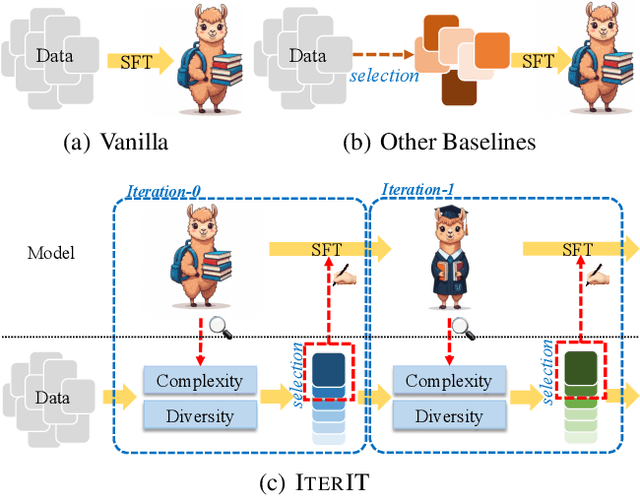
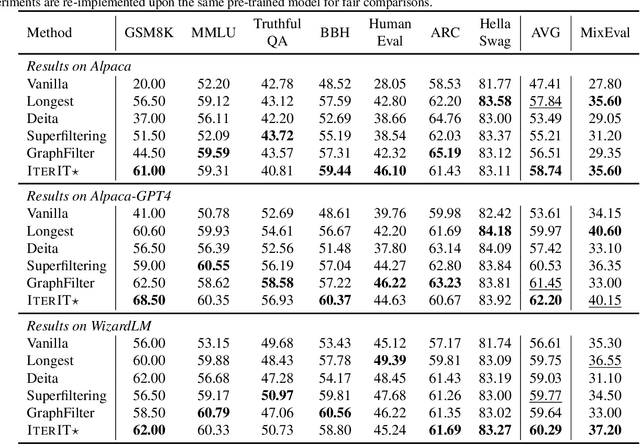

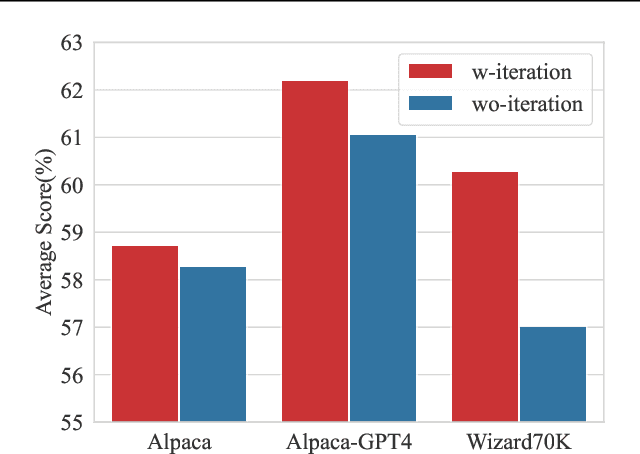
Abstract:Datasets nowadays are generally constructed from multiple sources and using different synthetic techniques, making data de-noising and de-duplication crucial before being used for post-training. In this work, we propose to perform instruction tuning by iterative data selection (\ApproachName{}). We measure the quality of a sample from complexity and diversity simultaneously. Instead of calculating the complexity score once for all before fine-tuning, we highlight the importance of updating this model-specific score during fine-tuning to accurately accommodate the dynamic changes of the model. On the other hand, the diversity score is defined on top of the samples' responses under the consideration of their informativeness. IterIT integrates the strengths of both worlds by iteratively updating the complexity score for the top-ranked samples and greedily selecting the ones with the highest complexity-diversity score. Experiments on multiple instruction-tuning data demonstrate consistent improvements of IterIT over strong baselines. Moreover, our approach also generalizes well to domain-specific scenarios and different backbone models. All resources will be available at https://github.com/JiaQiSJTU/IterIT.
Not Just Object, But State: Compositional Incremental Learning without Forgetting
Nov 05, 2024Abstract:Most incremental learners excessively prioritize coarse classes of objects while neglecting various kinds of states (e.g. color and material) attached to the objects. As a result, they are limited in the ability to reason fine-grained compositionality of state-object pairs. To remedy this limitation, we propose a novel task called Compositional Incremental Learning (composition-IL), enabling the model to recognize state-object compositions as a whole in an incremental learning fashion. Since the lack of suitable benchmarks, we re-organize two existing datasets and make them tailored for composition-IL. Then, we propose a prompt-based Composition Incremental Learner (CompILer), to overcome the ambiguous composition boundary problem which challenges composition-IL largely. Specifically, we exploit multi-pool prompt learning, which is regularized by inter-pool prompt discrepancy and intra-pool prompt diversity. Besides, we devise object-injected state prompting by using object prompts to guide the selection of state prompts. Furthermore, we fuse the selected prompts by a generalized-mean strategy, to eliminate irrelevant information learned in the prompts. Extensive experiments on two datasets exhibit state-of-the-art performance achieved by CompILer.
Visual Perception in Text Strings
Oct 02, 2024



Abstract:Understanding visual semantics embedded in consecutive characters is a crucial capability for both large language models (LLMs) and multi-modal large language models (MLLMs). This type of artifact possesses the unique characteristic that identical information can be readily formulated in both texts and images, making them a significant proxy for analyzing modern LLMs' and MLLMs' capabilities in modality-agnostic vision understanding. In this work, we select ASCII art as a representative artifact, where the lines and brightness used to depict each concept are rendered by characters, and we frame the problem as an ASCII art recognition task. We benchmark model performance on this task by constructing an evaluation dataset with an elaborate categorization tree and also collect a training set to elicit the models' visual perception ability. Through a comprehensive analysis of dozens of models, results reveal that although humans can achieve nearly 100% accuracy, the state-of-the-art LLMs and MLLMs lag far behind. Models are capable of recognizing concepts depicted in the ASCII arts given only text inputs indicated by over 60% accuracy for some concepts, but most of them achieves merely around 30% accuracy when averaged across all categories. When provided with images as inputs, GPT-4o gets 82.68%, outperforming the strongest open-source MLLM by 21.95%. Although models favor different kinds of ASCII art depending on the modality provided, none of the MLLMs successfully benefit when both modalities are supplied simultaneously. Moreover, supervised fine-tuning helps improve models' accuracy especially when provided with the image modality, but also highlights the need for better training techniques to enhance the information fusion among modalities.
SimulBench: Evaluating Language Models with Creative Simulation Tasks
Sep 11, 2024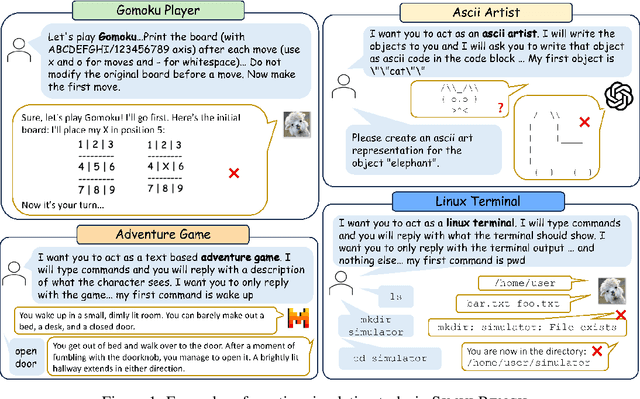

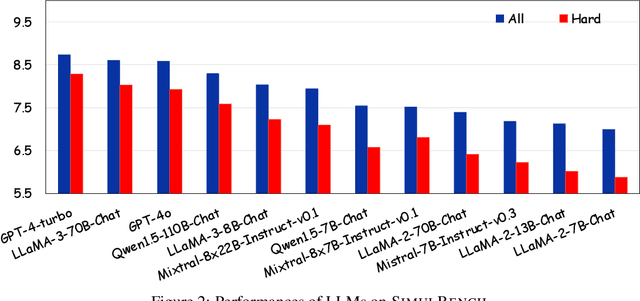
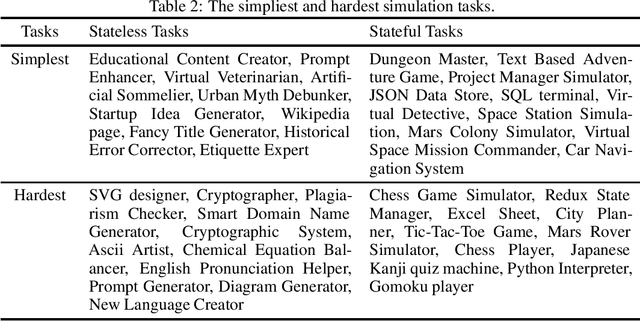
Abstract:We introduce SimulBench, a benchmark designed to evaluate large language models (LLMs) across a diverse collection of creative simulation scenarios, such as acting as a Linux terminal or playing text games with users. While these simulation tasks serve as effective measures of an LLM's general intelligence, they are seldom incorporated into existing benchmarks. A major challenge is to develop an evaluation framework for testing different LLMs fairly while preserving the multi-round interactive nature of simulation tasks between users and AI. To tackle this issue, we suggest using a fixed LLM as a user agent to engage with an LLM to collect dialogues first under different tasks. Then, challenging dialogue scripts are extracted for evaluating different target LLMs. To facilitate automatic assessment on \DataName{}, GPT-4 is employed as the evaluator, tasked with reviewing the quality of the final response generated by the target LLMs given multi-turn dialogue scripts. Our comprehensive experiments indicate that these simulation tasks continue to pose a significant challenge with their unique natures and show the gap between proprietary models and the most advanced open LLMs. For example, GPT-4-turbo outperforms LLaMA-3-70b-Chat on 18.55\% more cases.
Unseen No More: Unlocking the Potential of CLIP for Generative Zero-shot HOI Detection
Aug 12, 2024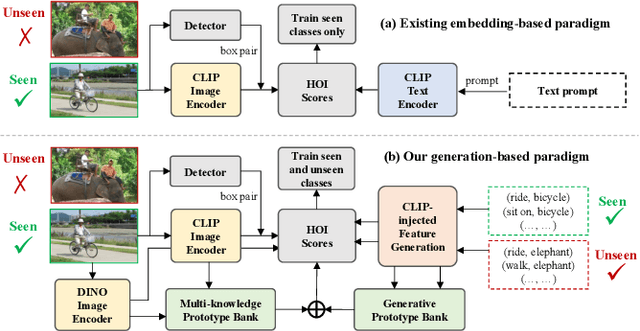
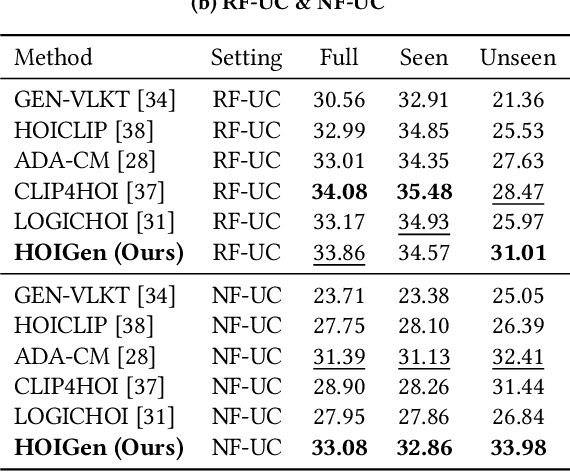
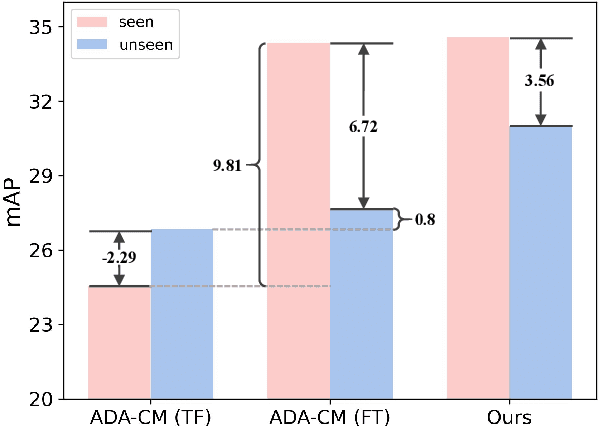
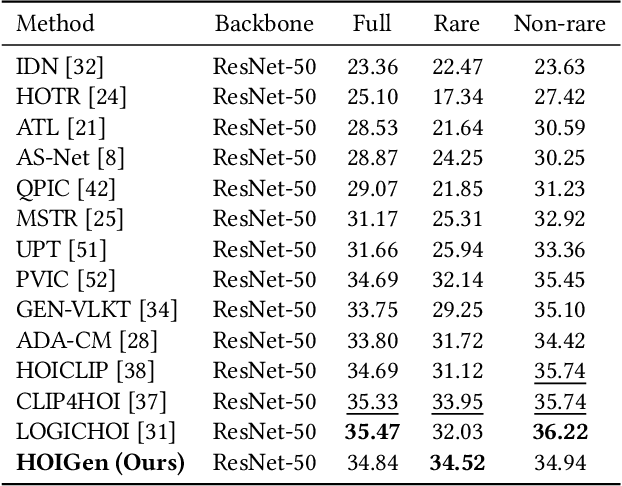
Abstract:Zero-shot human-object interaction (HOI) detector is capable of generalizing to HOI categories even not encountered during training. Inspired by the impressive zero-shot capabilities offered by CLIP, latest methods strive to leverage CLIP embeddings for improving zero-shot HOI detection. However, these embedding-based methods train the classifier on seen classes only, inevitably resulting in seen-unseen confusion for the model during inference. Besides, we find that using prompt-tuning and adapters further increases the gap between seen and unseen accuracy. To tackle this challenge, we present the first generation-based model using CLIP for zero-shot HOI detection, coined HOIGen. It allows to unlock the potential of CLIP for feature generation instead of feature extraction only. To achieve it, we develop a CLIP-injected feature generator in accordance with the generation of human, object and union features. Then, we extract realistic features of seen samples and mix them with synthetic features together, allowing the model to train seen and unseen classes jointly. To enrich the HOI scores, we construct a generative prototype bank in a pairwise HOI recognition branch, and a multi-knowledge prototype bank in an image-wise HOI recognition branch, respectively. Extensive experiments on HICO-DET benchmark demonstrate our HOIGen achieves superior performance for both seen and unseen classes under various zero-shot settings, compared with other top-performing methods. Code is available at: https://github.com/soberguo/HOIGen
 Add to Chrome
Add to Chrome Add to Firefox
Add to Firefox Add to Edge
Add to Edge